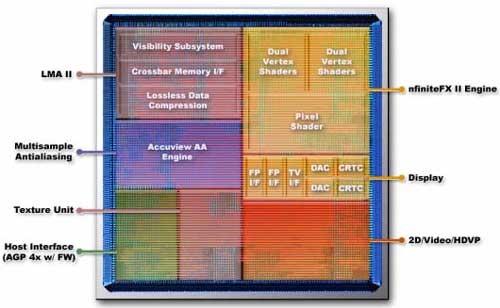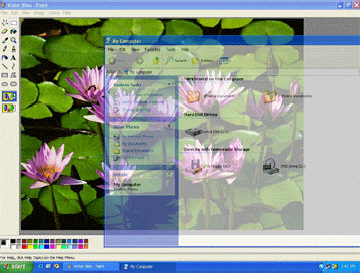|
|
GeForce4 Ti4600 |
GeForce4 Ti4400 |
GeForce4 Ti4200 |
|
Core
Size |
0.15m |
0.15m |
0.15m |
|
Core
Speed |
300
MHz Core |
275
MHz Core |
250
MHz Core |
|
Memory
Speed |
650
MHz Mem |
550
MHz Mem |
500
MHz Mem |
|
Memory
Width |
256
bit SDR (128 bit DDR) |
256
bit SDR (128 bit DDR) |
256
bit SDR (128 bit DDR) |
|
Memory Size |
128
MB |
128
MB |
128
MB |
|
Memory Bandwidth |
10.4 GB/s |
8.8
GB/s |
8
GB/s |
As we can see from the above, those are the
spec's as defined by nVidia for each of the GeForce 4 line of cards and the GS
Ultra/750XP adheres to those defined above.

Unlike the transition from the GeForce 2
-> GeForce 3 which was a revolutionary step, the GeForce 4 is more of an
evolutionary step. Based on GeForce 3 Technology, the GeForce 4 Ti's are built
on 0.15m (micron) technology which
allows the GeForce 4 to run up to 300 MHz core speed up from the 240 MHz the
GeForce 3 Ti500 runs. The nFinite FX engine found in the GeForce 3 has been
upgraded and the new nFinite FX II engine now has a second vertex shader which
allows the GeForce 4 Ti too pump out more polygons then ever before. The rest of
the nFinite FX II engine stays the same as the GeForce 3.
The Lightspeed Memory Architecture found in
the GeForce 4 has also been upgraded as well, the new LMA II has a vastly
improve Z-occlusion culling. Since most cards suffer from a great amount of
overdraw (pixels are rendered in a scene even though they're not visible),
nVidia tweaked the Z-occlusion. What this does is the GPU will sense what pixels
will and will not be rendered and those parts that will not be rendered won't
thus saving the bandwidth for other parts of the scene.
Also included in the LMA II architecture is
nVidia's Quad Cache. They are the Vertex Cache, Primitive Cache, Texture Cache
and Pixel Caches but unfortunately we don't know the size of the caches or how
they have been tweaked for better performance from the GeForce 3.
nView:
One of the great things about the whole
GeForce 4 line of cards (yes even the MX's) is nView. You remember nVidia's
attempt at dual display called TwinView with the GeForce2 MX? Well nView is more
then just dual display. The first thing that you will notice is that nVidia is
taking direct aim at the dual display world, with dual 350 MHz RAMDAC's this
ensures that a GeForce 4 videocard has sharp images even at 1600x1200. The GS
Ultra/750XP is special in, it is the only
GeForce 4 Ti that can support two DVI monitors at the same time. If you don't
use DVI, not to worry the Gainward also has two DVI to analog converters. If you
would like to use DVI and an analog based monitor that's also not a problem.

One of the neat options nView has is to allow
translucency of programs. For those of us who like to watch TV or need to
monitor another program nView makes that possible.
